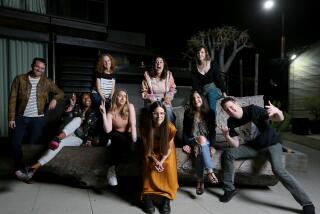Some Facts . . . From a Storyteller : Oral tradition is more than just folk tales and rhymes; it provides people with an important connection to their past.
- Share via
I was born in Saginaw, Mich., and there was very little theater. There were certain teachers who inspired my acting ability as a young kid. But I didn’t really find an avenue for acting until my family moved to California in 1956 looking for greater opportunities.
After I arrived, I enrolled at Pasadena City College, but I found myself hunting around to see what the acting scene was like. Finally I got involved with a theater group, but I didn’t start in storytelling until much later.
By 1970 I was teaching in the black studies department at UC Berkeley. At that time throughout the country, it was popular to do the “anti-whitey” thing, but I wasn’t into that. I wanted to get into something that related to the family.
So I got my students into doing folk tales, and we used “The Book of Negro Folklore” by Arna Bontempts and Langston Hughes for the class text. In the next two semesters we put on several productions. Some wonderful things came out of that class and it just stuck in my mind. When I moved back down here in 1975, I put it into play form.
In the beginning I did my stories in character and costume, but after meeting some other storytellers, such as Mildred Burch of Pasadena, who puts on an annual storytelling contest called “By Word of Mouth,” I discovered that many other storytellers perform in their own clothes.
There are three kinds of storytellers: those who started out as librarians, teachers and theater people. This is not acting or the performance of the story. It is telling a story. You can do it in a dramatic way by creating the story with facial or physical expressions, but the story is the most important thing.
For me, entertaining the audience is the most significant part in storytelling. To inform is part of it, but if you don’t hold the audience’s attention they won’t hold on to the information.
The way to make your story entertaining is to include several gimmicks--like I might throw in a song or include audience participation. For instance, there is an old folk tale that I tell about “Wylie and the Hairy Man.” The way I tell it, there is a lot of repetition, and every time I tell it, the kids start repeating the phrase “Gurgle, gurgle! Burble, burble!” over and over.
Most of my stories have a moral behind them. One of my favorites is “Prize Mule.” In that story there is a countywide contest for the best mule. Everybody expects the beautiful, groomed prize mule to win. But among the contestants is a unruly, ungroomed mule owned by a man known for his cheating and lying.
This man is determined to eliminate the prize mule because he feels it is his greatest competition.
So the night before the contest, the man sneaks into the barn of the prize mule and decides to bury him alive. He knocks down the mule, piles the dirt up high and leaves with the satisfaction that the mule is dead.
But the animal is only faking death, and immediately after the man leaves, the mule “just shakes off the dirt, stamps the ground and rises on up!”
The next day the lying and cheating man confidently parades his own mule. Immediately the man spots the prize mule among the contestants but thinks it’s a ghost because he’s certain he buried the mule the night before.
So he screams, runs out of the fairgrounds and has never been seen again.
As soon as I finish the story I tell the kids there is a lesson for everyone in how the prize mule reacted: Instead of trying to hit that lying and cheating person with a baseball bat, one should “just shake off the dirt, stamp on the ground and rise on up!”
Most people think it is an art form only for children, but it is for the entire community. We must take storytelling into places like the Mark Taper Forum and not just keep it in libraries, schools and small theaters.
Storytelling is more than just folk tales and rhymes; it provides a connection with our past. Oral tradition and the recounting of stories form the collected memory of the human race.
Storytelling captures and saves moments of our culture, and in the process it provides a history of all people.
Jazz eventually moved from the exclusive nightclub scene into places like Carnegie Hall and finally brought more respect to the art form. The same needs to happen for storytelling.






